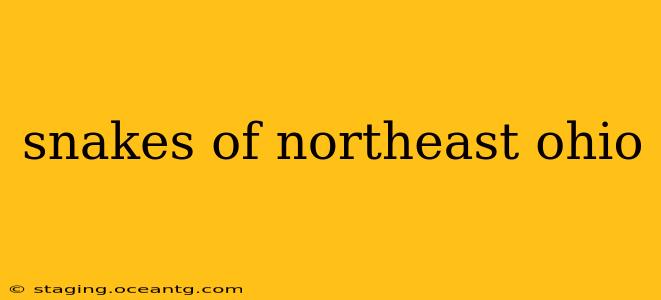Northeast Ohio boasts a surprisingly diverse population of snakes, many of which are harmless and play vital roles in the ecosystem. Understanding these reptiles is crucial for fostering coexistence and appreciating the natural world around us. This guide will explore the common snakes found in the region, addressing frequently asked questions and dispelling common myths.
What types of snakes live in Northeast Ohio?
Northeast Ohio is home to a variety of snake species, ranging in size, color, and habitat preference. Some of the most frequently encountered include:
- Eastern Garter Snake (Thamnophis sirtalis): These are arguably the most common snakes in the region, easily identifiable by their three distinct longitudinal stripes. They're slender, generally harmless, and often found near water sources.
- Northern Water Snake (Nerodia sipedon): These semi-aquatic snakes are larger than garter snakes and possess dark crossbands on a brownish or grayish body. They're often mistaken for venomous cottonmouths, but are entirely non-venomous.
- DeKay's Brown Snake (Storeria dekayi): A small, secretive snake with a uniform brown or grayish coloration. They are often found under rocks, logs, and leaf litter.
- Smooth Green Snake (Opheodrys vernalis): A striking, bright green snake typically inhabiting grassy meadows and fields. They are quite slender and non-venomous.
- Black Rat Snake (Pantherophis obsoletus): One of the larger snakes in the region, black rat snakes are powerful constrictors. While they can be intimidating due to their size, they are not venomous and play an important role in rodent control. (Note: Albino or amelanistic variations may also be found.)
- Eastern Fox Snake (Pantherophis gloydi): Similar in size and appearance to the black rat snake, the eastern fox snake is also a constrictor and not venomous. It has a more patterned appearance.
It's important to note that this list isn't exhaustive, and other species might occasionally be found within the region.
Are there any venomous snakes in Northeast Ohio?
While the majority of snakes in Northeast Ohio are harmless, there is one venomous species you should be aware of: the Eastern Massasauga Rattlesnake (Sistrurus catenatus). This rattlesnake is critically endangered and relatively rare in the region. Its bite can be dangerous, necessitating immediate medical attention. It's characterized by its dark brown or grayish coloration, dark blotches, and, of course, its rattle.
If you encounter a snake that you suspect might be venomous, maintain a safe distance and contact a wildlife professional or your local health authorities.
What should I do if I see a snake in my yard?
Most snakes are beneficial to your yard as they control rodent and insect populations. Unless the snake is venomous or poses an immediate threat, it's best to leave it alone. You can simply observe it from a distance and allow it to continue on its way. Creating a natural habitat with plenty of cover (brush piles, rock piles) can attract and support healthy snake populations. If you are truly uncomfortable, gently usher it away to a safer location using a long-handled tool, ensuring your safety and its well-being.
How can I identify a snake in Northeast Ohio?
Accurate identification often requires careful observation of physical characteristics such as size, color patterns, scale counts, and head shape. Field guides specific to Ohio snakes are invaluable resources. Consulting online resources (with caution) and contacting local herpetological societies or wildlife experts can provide further assistance.
What is the best way to prevent snakes from entering my home?
Preventing snakes from entering your home involves sealing any potential entry points – gaps around pipes, cracks in the foundation, holes in screens. Keeping your yard clean and tidy, minimizing brush piles near the house, and removing potential food sources (rodents) are also effective preventative measures.
Conclusion
The snakes of Northeast Ohio are an integral part of the region's biodiversity. By understanding their behavior and habits, we can coexist peacefully and appreciate these often-misunderstood creatures. Remember to prioritize safe observation and seek expert assistance when necessary. Remember, most snakes are harmless and play a crucial role in maintaining a healthy ecosystem. Learning to identify the snakes in your area promotes responsible interaction and helps protect these fascinating animals.
